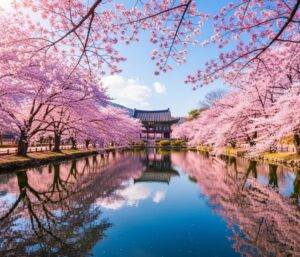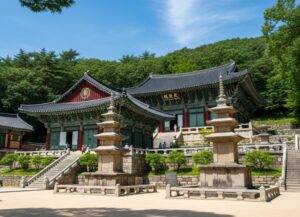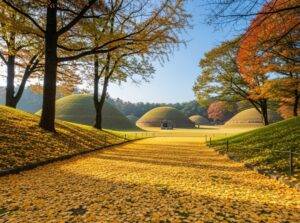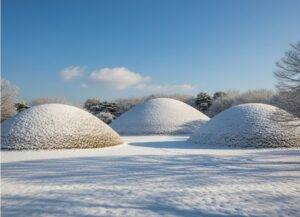So, you’re planning a trip to Gyeongju, the ancient capital of the Silla Kingdom and a place I lovingly call Korea’s “museum without walls.” It’s an incredible choice. But you’ve hit the big question: when is the best time to visit Gyeongju? The answer truly depends on the kind of experience you’re dreaming of.
Don’t worry, I’ve got you covered. As a traveler who has explored this city in every season, I’m here to break it down for you. This guide will walk you through the magic of Gyeongju—from its vibrant spring blossoms to its serene winter snow—so you can confidently choose the perfect time for your adventure.
Gyeongju in Spring (March – May): The City in Bloom
Spring is arguably the most famous season in Gyeongju, and for good reason. The entire city transforms into a postcard-perfect scene, blanketed in soft pink and white cherry blossoms. It’s a time of celebration and breathtaking beauty.
[Image: Vibrant pink cherry blossoms framing the iconic Bomun Pavilion, reflected in the calm lake waters in Gyeongju during spring.]
Spring Weather in Gyeongju
You can expect mild and pleasant weather. It starts cool in March and warms up beautifully by May, making it ideal for walking and exploring.
- Average Temperatures: 4°C to 22°C (39°F to 72°F)
Pros: Why You’ll Love Spring
- Peak Scenery: The cherry blossoms are simply magical. The entire city feels alive and vibrant.
- Comfortable Weather: The temperatures are perfect for long days spent exploring historical sites on foot or by bicycle.
- Festivals: The season kicks off with events like the Gyeongju Cherry Blossom Marathon, bringing a lively atmosphere to the city.
Cons: What to Watch Out For
- The Crowds: This is peak season. Be prepared for large crowds, especially at famous photo spots like Bomun Lake and the Daereungwon Tomb Complex.
- Higher Prices: Flights and accommodation will be at their most expensive. You’ll need to book well in advance.
Must-See: Gyeongju in Spring Cherry Blossoms
The cherry blossoms are the main event. For the best views, rent a bike and cycle the path around Bomun Lake, or take a stroll through the Daereungwon Tomb Complex where the ancient burial mounds are surrounded by blooming trees. The sight is truly unforgettable.
Ready to plan your spring trip? Find the best Gyeongju hotel deals here.
Gyeongju in Summer (June – August): Lush Greens and Long Days
Summer drapes Gyeongju in a blanket of deep, lush green. The days are long, the foliage is vibrant, and historical sites like the Bulguksa Temple look stunning against the verdant backdrop.
[Image: The lush, green grounds of Bulguksa Temple on a bright summer day, with traditional Korean architecture visible.]
Summer Weather in Gyeongju
Be prepared for heat and humidity. July and August are also part of Korea’s monsoon season (jangma), so expect some rainy days.
- Average Temperatures: 20°C to 30°C (68°F to 86°F)
Pros: Why Visit in Summer
- Vibrant Landscapes: The trees and rice paddies are at their greenest, creating beautiful, rich scenery.
- Longer Days: More daylight hours mean more time to explore.
- Unique Sights: See the lotus flowers in full bloom at Anapji Pond (Donggung Palace and Wolji Pond), which is a spectacular sight, especially at night.
Cons: The Heat and Humidity
- Uncomfortable Weather: The humidity can be intense, which can make walking around during midday challenging.
- Monsoon Season: You’ll need to pack an umbrella and be flexible with your plans due to potential rain showers.
Pro Tip: A Smart Gyeongju Summer Itinerary
To beat the heat, structure your days like a local. Explore outdoor sites like the tomb complexes early in the morning (7-11 AM) or late in the afternoon (after 4 PM). Spend the hottest part of the day inside at the Gyeongju National Museum or relaxing in one of the city’s charming cafes in the Hwanglidan-gil area.
Ready for a summer adventure? Check out these recommended Gyeongju tours.
Gyeongju in Autumn (September – November): A Tapestry of Colors
For many, autumn is the best time to visit Gyeongju. The oppressive summer humidity disappears, leaving crisp, clear air. The city’s ginkgo and maple trees erupt in spectacular shades of gold, orange, and crimson.
[Image: A pathway covered in golden ginkgo leaves in Gyeongju during autumn, with ancient tombs in the background.]
Autumn Weather in Gyeongju
The weather is nearly perfect: warm, sunny days and cool, comfortable evenings. It is arguably the most pleasant season for travel.
- Average Temperatures: 7°C to 23°C (45°F to 73°F)
Pros: The Golden Season’s Charm
- Stunning Fall Foliage: The colors are breathtaking, especially around Bulguksa Temple and the forests surrounding Namsan Mountain.
- Ideal Weather: The climate is perfect for any activity, from hiking to city exploration.
- Cultural Festivals: Autumn often hosts major events like the Silla Cultural Festival.
Cons: Planning is Key
- Popular Season: Like spring, autumn draws significant crowds, though it can be slightly less intense than the cherry blossom peak.
- Holiday Traffic: The Chuseok holiday can make travel difficult if you don’t plan ahead.
Special Note: Visiting Gyeongju During Chuseok
Chuseok (Korean Thanksgiving) is one of Korea’s biggest holidays, typically falling in September or October. While it’s a beautiful cultural experience, be aware that many Koreans travel to their hometowns. This means train and bus tickets sell out months in advance, and some smaller shops and restaurants may be closed. If your trip falls over Chuseok, book everything far in advance!
Packing Guide: What to Wear in Gyeongju in Autumn
The key is layering. Days can be warm, but temperatures drop significantly once the sun goes down. Pack a mix of t-shirts, long-sleeved shirts, a comfortable sweater or fleece, and a light jacket. Comfortable walking shoes are a must.
Dreaming of a fall foliage trip? Secure your perfect Gyeongju accommodation now.
Gyeongju in Winter (December – February): Serene and Uncrowded
Winter in Gyeongju is quiet, crisp, and beautifully serene. The crowds are gone, leaving you to explore the ancient tombs and temples in peaceful solitude. A light dusting of snow on the traditional hanok roofs is a truly magical sight.
[Image: A serene winter scene of Daereungwon Tomb Complex lightly covered in snow under a clear blue sky.]
Winter Weather in Gyeongju
It is cold and dry, but generally sunny. Snow isn’t guaranteed but can happen, adding to the beauty.
- Average Temperatures: -5°C to 6°C (23°F to 43°F)
Pros: The Quiet Beauty
- Fewer Tourists: You’ll have major historical sites almost to yourself. It’s an intimate and personal way to experience the city.
- Lower Prices: This is the budget season. You can find excellent deals on flights and hotels.
- Stunningly Clear Skies: Winter often brings crisp, clear days, perfect for photography.
Cons: The Winter Chill
- Cold Weather: You’ll need to bundle up properly to stay warm while exploring outdoors.
- Shorter Days: The sun sets early, giving you fewer daylight hours for sightseeing. Some attractions may have shorter winter hours.
Looking for a peaceful winter escape? Find great deals on winter stays in Gyeongju here.
The Verdict: What’s the Best Time for YOU to Visit Gyeongju?
Ultimately, the perfect time depends on your personal travel style.
- Best for Photographers & Scenery Lovers: Spring (late March to early April). For the iconic cherry blossom photos, nothing beats spring. The runner-up is Autumn (late October to mid-November) for the vibrant fall colors.
- Best for Pleasant Weather & Outdoor Activities: Autumn (September to November). The weather is unbeatable, making it ideal for hiking, biking, and exploring every corner of the city.
- Best for Budget Travelers & Crowd Haters: Winter (December to February). You’ll get the lowest prices and the most peaceful experience, allowing you to connect with the city’s history on a deeper level.
- Best for Lush Landscapes: Summer (June to August). If you don’t mind the heat and want to see Gyeongju at its most green and vibrant, summer is your season.
Frequently Asked Questions (FAQ): The Best Time to Visit Gyeongju: A Complete Seasonal Guide
How many days do I need to see Gyeongju?
I recommend a minimum of two full days. This gives you one day to explore the downtown historical area (Daereungwon, Cheomseongdae, Hwanglidan-gil) and a second day for sites further out, like Bulguksa Temple and Seokguram Grotto. Three days is even better for a more relaxed pace.
Is Gyeongju worth visiting in winter?
Absolutely! While it is cold, the lack of crowds offers a unique and serene experience. Seeing the ancient tombs lightly dusted with snow is a magical sight you won’t get at any other time of year. It’s a fantastic option for budget-conscious travelers.
What is the easiest way to get around Gyeongju?
The city center is very walkable. For reaching sites like Bulguksa Temple, the local city buses are frequent and easy to use (use a T-Money card and an app like Naver or Kakao Maps). Renting a bicycle is also a popular and fun way to explore the areas around the tomb complexes and Bomun Lake.
Hi, I’m [jeybee]. As a long-time resident of Seoul, I’m passionate about uncovering the authentic, everyday magic of Korea. This blog is my way of sharing my favorite spots, tips, and cultural insights with you, beyond the usual tourist traps.





